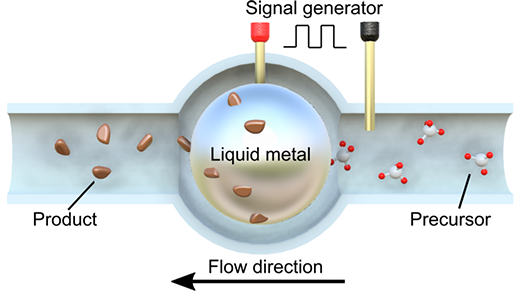| Nov 12, 2021 |
No more moving parts: Liquid metal enabled chemical reactors
(Nanowerk News) Liquid-metal machines could wipe out maintenance issues for continuous flow reactors.
|
|
Metals that are liquid at room temperature, such as gallium and its alloys, are attractive materials due to their unique electrical, thermal and fluidic properties.
|
|
In a study published in the journal Matter ("Liquid metal enabled continuous flow reactor: A proof-of-concept"), a research team led by UNSW, Sydney has shown that liquid metals can offer their characteristics to the pharmaceutical and chemical industries, with the possible elimination of moving parts in continuous flow reactors providing improved performance and reduced maintenance costs.
|
|
Traditional mechanical pumps and moving parts could potentially be replaced by ‘soft’ components that literally never failed in the life of the machine.
|
Zero moving parts for better flow reactors
|
|
Flow reactors are being increasingly adopted in pharmaceutical and chemical industries, with their operation and maintenance representing an important factor in these industries.
|
|
Continuous flow reactors allow fast reactions, offer safe control, and enable easy scaling-up opportunities. More than ever these industries are inclined to implement flow reactors for increasing product quality and yield of chemical and biochemical reactions.
|
|
However, one of the most important technological issues is with the core components of such reactors, which generally use moving parts, which can be fouled, blocked, and broken via precipitation of materials, hence compromising the productivity and longevity of the systems.
|
|
One possibility to overcome such drawbacks, while keeping the functionalities of the continuous flow reactor, is replacing the traditional mechanical pumps and moving parts with soft and never-failing components.
|
|
Liquid metals exhibit the potential to design continuous flow reactors as their low melting point, non-toxicity, controllable shape, and reactive surface offer what efficient and durable flow reactors require.
|
|
Interestingly, the flow formed around the liquid metal reactive core, called Marangoni flow when an external voltage is applied, eliminates the need for moving parts and relies instead on surface tension to do the pumping of the flow.
|
|
Additionally, the active surface of the liquid metal facilitates chemical reactions.
|
|
Thus, the liquid metal simplifies the continuous flow reactor design, and it plays two critical roles in the system for material synthesis and also for mass transport.
|
 |
| A liquid metal droplet as the core of a continuous flow reactor for both chemical reaction and mass transport. (Image: UNSW)
|
|
In their work, the researchers from UNSW, and their collaborators from Queensland University of Technology (QUT), Australia, and University of California, Los Angles (UCLA), USA, demonstrated a continuous flow reactor enabled by liquid metal droplets in their cores.
|
|
The team introduced three different model examples into the reactor to produce three popular functional materials:
|
|
manganese oxide, which is widely utilized for the synthesis of soft ferrites
graphene, which is used in many applications such as those in water purification and energy storage/conversion, and
molybdenum sulphide, which is known for its new applications in microelectronics.
|
|
The system showed versatile capabilities for generating materials with tuneable system performance and controlled material quality.
|
|
“The liquid metal can be easily integrated into a fluidic channel for constructing the continuous flow reactor,” said Mr Jialuo Han, the first author of the work. He added “The liquid metal itself can spontaneously produce materials on the surface and the material is repelled away from its surface with the application of an external voltage.”
|
|
“This proof-of-concept continuous flow reactor is enabled by a single droplet of liquid metal, which can be extended for synthesizing many different valuable materials with high-quality control,” said Dr Mohannad Mayyas, a corresponding author of this study. “It has no mechanical parts and can in principle be readily scaled up for future commercialization.”
|

